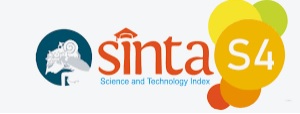Peramalan Persediaan Beras Bulog di Kabupaten Manokwari Menggunakan Autoregressive Integrated Moving Average
Abstract
Rice is one of the main components in the food sector which plays an important role in maintaining food supply stability. The main challenge in this case is maintaining Bulog's rice supply to remain stable. This research was conducted to support efforts to overcome food supply stability at Perum Bulog Manokwari by forecasting future Bulog rice supplies. The method used to predict Bulog's rice supply is the ARIMA model. From the application of the ARIMA method, the ARIMA(1,0,0) model was obtained with an accuracy level measured by an RMSE value of 107,908.4 and an error percentage of 15.71%. Forecasting Bulog's rice supplies using the ARIMA method is carried out for the next six month period, from January to June 2024.Â
Keywords: Forecasting; Bulog Rice; ARIMA
Â
Abstrak
Beras merupakan salah satu komponen utama dalam sektor pangan yang memegang peranan penting dalam menjaga stabilitas pasokan pangan. Tantangan utama dalam hal ini adalah menjaga persediaan beras Bulog agar tetap stabil. Penelitian ini dilakukan untuk mendukung upaya dalam mengatasi stabilitas pasokan pangan di Perum Bulog Manokwari dengan melakukan peramalan terhadap persediaan beras bulog di masa mendatang. Metode yang digunakan dalam melakukan prediksi persediaan beras Bulog adalah Model ARIMA. Dari penerapan metode ARIMA, didapatkan model ARIMA(1,0,0) dengan tingkat akurasi yang diukur dari nilai RMSE sebesar 107.908,4 dan persentase kesalahan sebesar 15,71%. Peramalan persediaan beras Bulog menggunakan metode ARIMA dilakukan untuk periode enam bulan mendatang, mulai dari Januari hingga Juni 2024. Â
Â
Keywords
References
A. K. Qanita, D. H. Nabila, and A. Nabyla, “Analisis Kebijakan Ketersedian Stok Beras (Studi Kasus Pada Pergudangan Beras Perum Bulog Kota Palu) The policy analysis of rice stock availability (case study on rice warehouse of Palu Perum Bulog),†Agrotekbis, vol. 2, no. 1, pp. 537–543, Feb. 2014.
M. R. Abonazel and A. I. Abd-Elftah, “Forecasting Egyptian GDP using ARIMA models,†Reports on Economics and Finance, vol. 5, no. 1, pp. 35–47, 2019, doi: 10.12988/ref.2019.81023.
R. D. Ayu, “PRISMA, Prosiding Seminar Nasional Matematika Peramalan Metode ARIMA Data Saham PT. Telekomunikasi Indonesia,†Peramalan Metode ARIMA Data Saham PT. Telekomunikasi Indonesia. PRISMA, Prosiding Seminar Nasional Matematika, vol. 4, pp. 611–620, 2021, [Online]. Available: https://journal.unnes.ac.id/sju/index.php/prisma/
Q. A. Khairunnisa et al., “Aplikasi Metode Arima Dalam Meramalkan Rata-Rata Harga Beras Di Tingkat Perdagangan Besar (Grosir) Indonesia,†Jurnal Agribisnis, vol. 24, no. 2, pp. 227–238, 2022.
N. Salwa et al., “Peramalan Harga Bitcoin Menggunakan Metode ARIMA (Autoregressive Integrated Moving Average),†Journal of Data Analysis, vol. 1, no. 1, pp. 21–31, May 2018.
F. Ramadhani, K. Sukiyono, and M. Suryanty, “Forecasting of Paddy Grain and Rice’s Price: An ARIMA (Autoregressive Integrated Moving Average) Model Application,†SOCA: Jurnal Sosial, Ekonomi Pertanian, vol. 14, no. 2, p. 224, May 2020, doi: 10.24843/soca.2020.v14.i02.p04.
B. KATHAYAT and A. K. DIXIT, “Paddy price forecasting in India using ARIMA mode,†Journal of Crop and Weed, vol. 17, no. 1, pp. 48–55, Jan. 2021, doi: 10.22271/09746315.2021.v17.i1.1405.
F. A. Elsa, D. Nabila, D. Melenia, A. L. Guntoro, A. N. Salwa, and S. Fadilah, “Peramalan Harga Beras Pada Pasar Tradisional Di Indonesia Dengan Menggunakan Model Arima,†dwijenAGRO, vol. 11, no. 1, pp. 12–16, 2021.
S. Fachrurrazi, P. Angga, S. Syukriah, and V. Ilhadi, “Penerapan Fuzzy Times Series dan Regresi Linier dalam Melihat Stok Ketersediaan Beras,†METIK JURNAL, vol. 7, no. 1, pp. 26–35, Jun. 2023, doi: 10.47002/metik.v7i1.561.
P. Mondal, L. Shit, and S. Goswami, “Study of Effectiveness of Time Series Modeling (Arima) in Forecasting Stock Prices,†International Journal of Computer Science, Engineering and Applications, vol. 4, no. 2, pp. 13–29, Apr. 2014, doi: 10.5121/ijcsea.2014.4202.
A. K. Sahai, N. Rath, V. Sood, and M. P. Singh, “ARIMA modelling & forecasting of COVID-19 in top five affected countries,†Diabetes and Metabolic Syndrome: Clinical Research and Reviews, vol. 14, no. 5, pp. 1419–1427, Sep. 2020, doi: 10.1016/j.dsx.2020.07.042.
N. Demirbaş and O. Akouegnonhou, “Forecasting of rice self-sufficiency in the Benin Republic using ARIMA model,†Selcuk Journal of Agricultural and Food Sciences, vol. 33, no. 3, pp. 204–214, Nov. 2019, doi: 10.15316/sjafs.2019.177.
Y. Namira, A. Nuhung, and D. M. Najamuddin, “Analisis Faktor-Faktor Yang Mempengaruhi Impor Beras Di Indonesia,†Jurnal Agribisnis, vol. 11, no. 6, pp. 183–201, 2017, [Online]. Available: www.bi.go.id.
N. Iqbal, K. Bakhsh, A. Maqbool, and A. Shohab Ahmad, “Use of the ARIMA Model for Forecasting Wheat Area and Production in Pakistan.†Journal of Agriculture and Social Sciences, vol. 1, no. 2, pp. 120-122, 2015. [Online]. Available: http://www.ijabjass.org
G. Bandyopadhyay, “Gold Price Forecasting Using ARIMA Model,†Journal of Advanced Management Science, Vol. 5, No. 3, pp. 117–121, 2016, doi: 10.12720/joams.4.2.117-121.
K. Albeladi, B. Zafar, and A. Mueen, “Time Series Forecasting using LSTM and ARIMA,†IJACSA) International Journal of Advanced Computer Science and Applications, vol. 14, no. 1, pp. 313–320, 2023, [Online]. Available: www.ijacsa.thesai.org
P. A. D. Kusbianto and P. A. Nugroho, “Perbandingan Metode FTS Dan MA pada Peramalan Persediaan Beras di Kabupaten Malang.†Jurnal Informatika Polinema, vol. 6, no. 3, pp. 29-36, 2020.
How To Cite This :
Refbacks
- There are currently no refbacks.











